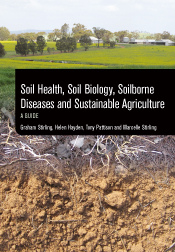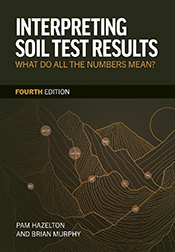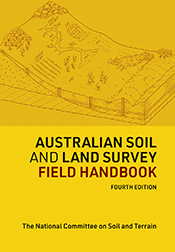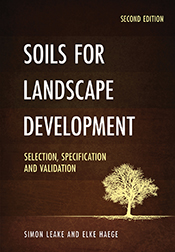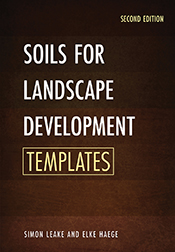Soil Health, Soil Biology, Soilborne Diseases and Sustainable Agriculture
A Guide
By: Graham Stirling, Helen Hayden, Tony Pattison, Marcelle StirlingHelps growers make the transition to an ecologically based form of agriculture by providing holistic solutions to soilborne diseases.
Our capacity to maintain world food production depends heavily on the thin layer of soil covering the Earth's surface. The health of this soil determines whether crops can grow successfully, whether a farm business is profitable and whether an enterprise is sustainable in the long term. Farmers are generally aware of the physical and chemical factors that limit the productivity of their soils but often do not recognise that soil microbes and the soil fauna play a major role in achieving healthy soils and healthy crops. + Full description
Soil Health, Soil Biology, Soilborne Diseases and Sustainable Agriculture provides readily understandable information about the bacteria, fungi, nematodes and other soil organisms that not only harm food crops but also help them take up water and nutrients and protect them from root diseases. Complete with illustrations and practical case studies, it provides growers and their consultants with holistic solutions for building an active and diverse soil biological community capable of improving soil structure, enhancing plant nutrient uptake and suppressing root pests and pathogens.
The book is written by scientists with many years' experience developing sustainable crop production practices in the grains, vegetable, sugarcane, grazing and horticultural industries.
This book will be useful for: growers, consultants, agronomists and soil chemists, extension personnel working in the grains, livestock, sugarcane and horticultural industries, professionals running courses in soil health/biological farming, and students taking university courses in soil science, ecology, microbiology, plant pathology and other biological sciences. - Short description
Details
Paperback | March 2016 | $ 99.95ISBN: 9781486303045 | 280 pages | 245 x 170 mm
Publisher: CSIRO Publishing
Colour photographs, Illustrations
ePDF | March 2016
ISBN: 9781486303052
Publisher: CSIRO Publishing
Available from eRetailers
Features
- Provides examples from Australian agriculture
- Shows growers how to make the transition to an ecologically based form of agriculture to manage soilborne diseases and reduce losses through practice change
- Dispels misinformation and complements existing material
- A comprehensive and readable coverage of the causes and effects of soilborne diseases
- Discusses the fundamentals of soil biota and the key pathogens in Australian agriculture
- Gives a step-by-step guide to biological processes to minimising losses to diseases
Contents
PrefaceCHAPTER 1
Introduction: soil health, soil biology, sustainable agriculture and evidence-based information
CHAPTER 2
Soil physical, chemical and biological properties and the key role of organic matter in promoting soil and plant health
CHAPTER 3
Organisms in the soil food web and their functions
CHAPTER 4
Soilborne diseases: a major impediment to crop production
CHAPTER 5
Impact of natural enemies on soilborne pathogens
CHAPTER 6
A practical guide to improving soil health and reducing losses from soilborne diseases
CHAPTER 7
Grain farming systems to improve soil health and enhance biological suppression of soilborne diseases
CHAPTER 8
Annual and perennial pastures to improve soil health in grain-cropping systems
CHAPTER 9
Yield decline of sugarcane: a soil health problem overcome by modifying the farming system
CHAPTER 10
Vegetable farming systems: the challenge of improving soil health and sustainability in an industry that demands high levels of productivity
CHAPTER 11
Options for improving soil health and minimising losses from soilborne diseases in perennial horticultural crops
CHAPTER 12
Key soil health messages, and practices that should be included in holistic soil improvement programs
CHAPTER 13
Further reading
Index
Authors
Dr Graham Stirling, with his wife Marcelle, runs a company that provides research and disease diagnostic services to Australia’s rural industries. His areas of expertise are Plant Pathology, Nematology and Soil Ecology. In a career spanning 45 years, he has worked on many of the crops grown in Australia and published more than 100 peer-reviewed papers.
Dr Helen Hayden is a Soil Microbial Ecologist at the Department of Economic Development, Jobs, Transport and Resources in Victoria. She completed her PhD at the University of Queensland, specialising in diseases of bananas, and her recent research has been on disease suppressive soils for Rhizoctonia in cereals.
Dr Tony Pattison is the Principal Nematologist and Soil Health team leader for horticulture within the Queensland Department of Agriculture, where he investigates plant-parasitic nematodes and soil health in a diverse range of tropical horticultural crops. His interest in soil ecology and disease suppression currently focuses on competition for carbon within the soil.
Dr Marcelle Stirling is a Plant Pathologist and Microbiologist and has worked on many aspects of soil biology. Her research career began at the University of California, Riverside, where she studied nematode-trapping fungi. Together with Graham, she now provides research and plant disease diagnostic services to Australia’s rural industries.

